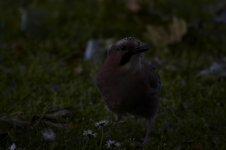-
Welcome to BirdForum, the internet's largest birding community with thousands of members from all over the world. The forums are dedicated to wild birds, birding, binoculars and equipment and all that goes with it.
Please register for an account to take part in the discussions in the forum, post your pictures in the gallery and more.
You are using an out of date browser. It may not display this or other websites correctly.
You should upgrade or use an alternative browser.
You should upgrade or use an alternative browser.
Raw (1 Viewer)
- Thread starter vidler23
- Start date
More options
Who Replied?SeanKP
Fledgling
Hi Vidlervidler23 said:I know this question has proberely been asked before. Are there any advantages to shooting in raw image. I know the editing process takes longer, but do you actually get a better image at the end of the day.
Thanks
:h?:
I always shoot RAW these days. Not necessarily do you get a better image but you have more latitude over the post-processing and to correct mistakes. I'm no expert but as I understand it a JPEG is a compressed file with the camera settings at the time the photo was taken (contrast, brightness, white balance, etc.) 'fixed' into it. A RAW image contains all the data that hits the sensor before any manipulation takes place in the camera.
What this means in practice is that you can effectively set these settings after taking the photo ensuring that you get them just right. Additionally, you have much finer control over the settings than you do in the camera.
Also, because you have much more information available it is possible to correct under or over exposures (by as much as a stop) with relatively small amount of noise introduced.
I began shooting RAW for my underwater photography and the results that you can achieve with the white balance are so amazing that I was sold on it.
Hope this helps.
Sean
redshift
Toad Popper
vidler23 said:I know this question has proberely been asked before. Are there any advantages to shooting in raw image. I know the editing process takes longer, but do you actually get a better image at the end of the day.
Thanks
:h?:
Many many more levels of luminance. 12-bit in RAW v 8-bit for JPG. This means you have far more latitude in correcting exposure errors up or down without ruining the image.
Having the RAW data has been likened to having the exposed but undeveloped film. You can choose how to develop it.
Chuck A. Walla
Well-known member
I only shoot RAW now. JPG works fine if you never make any mistakes but birds can pop up unexpectedly from anywhere and I often only have a single chance at them.
Yelvertoft
Rabbit Fan
jacksnipe said:sorry for being a bit of athicky,but I keep reading about raw,but what is it about.Is it a setting that you have to to have on your camera.Could someone please explain.thankyou.
An explanation can be found here:
http://www.dpreview.com/learn/?/Glossary/Digital_Imaging/RAW_01.htm
Do a Google, there's lots of tutorials and primers that explain far better than I can.
Not all cameras allow you to capture the RAW information for processing outside the camera on your PC. Most point and shoot models will not let you get at the RAW info, only the jpeg after the camera has done its processing internally. You wil usually only find RAW capture as an option with dSLR models and some of the higher end prosumer fixed lens cameras.
Personally, I rarely use RAW in day to day use, infrared work being the only regular exception to this because of the large amount of post processing that inevitably comes with this type of photography. In a previous discussion on this subject, I think Andy Bright summed it up best with his comment "Life's too short for RAW". Each to their own, but fine JPEG is good enough for my needs 95% of the time.
Hope this helps,
Duncan.
Keith Reeder
Watch the birdie...
Just to confuse things a wee bit, some manufacturers (most notably Nikon) name their RAW format differently - Nikon's proprietary name is NEF...
RAH
Well-known member
I also want to point out that MANY digital cameras, including most if not all point-and-shoots, do not have the ability to create RAW files. So, if you can't find it, it probably isn't there.jacksnipe said:sorry for being a bit of athicky,but I keep reading about raw,but what is it about.Is it a setting that you have to to have on your camera.Could someone please explain.thankyou.
SeanKP
Fledgling
Here is an extreme example of why I shoot RAW. This is a shot of a jay I took only a couple of weeks after I first got my camera. I'd been taking pictures of birds in trees against the sky shooting in manual mode when I suddenly noticed this jay on the ground. I got off a couple of shots but didn't have the experience nor presence of mind to adjust my settings. The first image is straight out of the camera with no adjustments made. The second, I've adjusted the exposure in PS, cropped and sharpened the image. OK, the second image isn't very good but it's my only jay shot and a LOT better than if I'd been trying to rescue a JPEG.
Attachments
compa
Well-known member
RAW is there largely for when you screw things up! But even without it you can recover just fine in many, if not most, cases. The previous post by SeanKP offered an example that he considered "extreme" of recovering from a RAW file - as evidenced by jpeg versions of the file.
Well ... look here at what can be accomplished from the low quality JPEG he posted as the example: http://www.jbs-blog.com/images/offsite/jay_original%5b1%5d.jpg
I think my recovery from the web quality JPEG is every bit as good as his recovery from the RAW. Indeed in most cases you can still recover very nicely from a JPEG. I'm not saying that RAW is inferior in any way but I personally find it to be a waste of time. It takes up too much room on the memory card - it takes up too much space on the hard drive - it is too slow to display - it is very hard to just browse a group of files.
I just don't find RAW to be worth the extra bother for day to day shooting. But your mileage may vary 3
Well ... look here at what can be accomplished from the low quality JPEG he posted as the example: http://www.jbs-blog.com/images/offsite/jay_original%5b1%5d.jpg
I think my recovery from the web quality JPEG is every bit as good as his recovery from the RAW. Indeed in most cases you can still recover very nicely from a JPEG. I'm not saying that RAW is inferior in any way but I personally find it to be a waste of time. It takes up too much room on the memory card - it takes up too much space on the hard drive - it is too slow to display - it is very hard to just browse a group of files.
I just don't find RAW to be worth the extra bother for day to day shooting. But your mileage may vary 3
DOC
Well-known member
I agree that Raw has beter post processing features but it also takes up a lot of space and it is time consuming.
I personally find the high quality jpeg more than enough for my needs, unless you intend to print large blow-ups of your pictures or you need the pics for an exibition etc..-then shoot RAW.
I personally find the high quality jpeg more than enough for my needs, unless you intend to print large blow-ups of your pictures or you need the pics for an exibition etc..-then shoot RAW.

Tiff is just an uncompressed image format, where-as RAW is specifically the image taken before any in-camera processing takes place.Macswede said:What's the difference between Raw and Tiff, or to put my question another way is Tiff eesntially a Raw format?
cheers,
Andy
jimtfoto
Well-known member
Just to add another two cents (Cdn) ... we just switched a couple of months ago to shooting RAW+JPG (small) on our Canons. The control over final image is amazing whether you are using PSCS or RSE, or other RAW conversion programs. The JPGs are used to make contact sheets.
cheers,
jim
cheers,
jim
Macswede
Macswede
Andy Bright said:Tiff is just an uncompressed image format, where-as RAW is specifically the image taken before any in-camera processing takes place.
cheers,
Andy
Thanks Andy,
That's more or less what I thought but I suddenly realized that I was uncertain.
Graham
Users who are viewing this thread
Total: 2 (members: 0, guests: 2)





